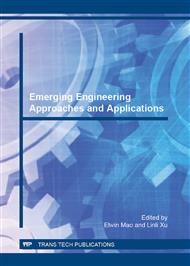p.38
p.42
p.47
p.52
p.57
p.62
p.66
p.71
p.76
LEC-AODV Routing Protocol Based on Load and Energy Classification
Abstract:
Now widely used AODV routing protocol does not take into account the node’s load size and energy level. During the route discovery process, AODV routing protocol often has the blindness and makes it easy to bring about network congestion and consume some node’s energy excessively. To solve this problem, this paper presents a new LEC-AODV routing protocol based on load and energy classification, which makes a different response according to the node’s load size and energy level. Simulation results show that the protocol does not significantly increase the complexity of traditional AODV routing algorithm when packet delivery ratio, average end-to-end delay and network lifetime and other indicators have improved in varying degrees. At the same time it can bypass the nodes with heavy load and low energy, thereby achieve a certain degree of flow and energy balance and successfully solve the QoS problem in tactical MANETs.
Info:
Periodical:
Pages:
57-61
Citation:
Online since:
September 2011
Authors:
Keywords:
Permissions:
Share:
Citation:


